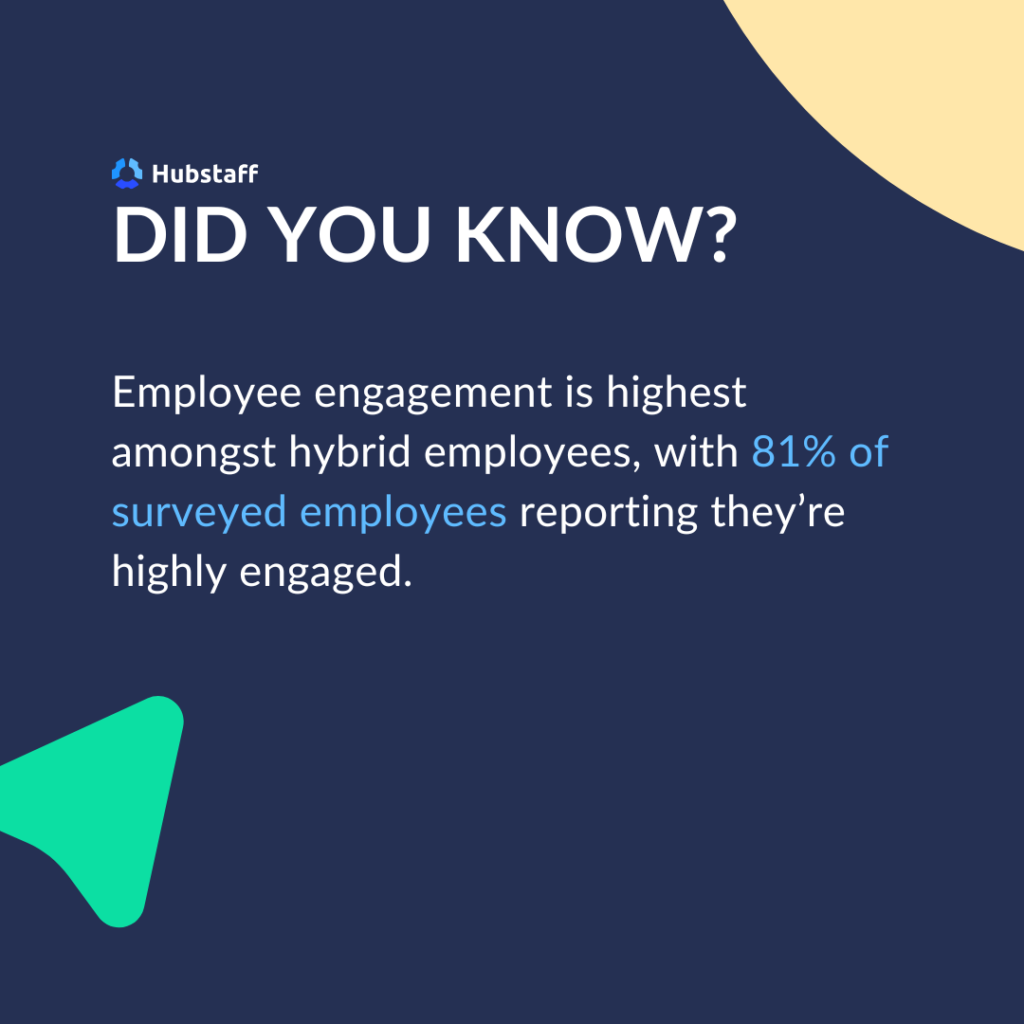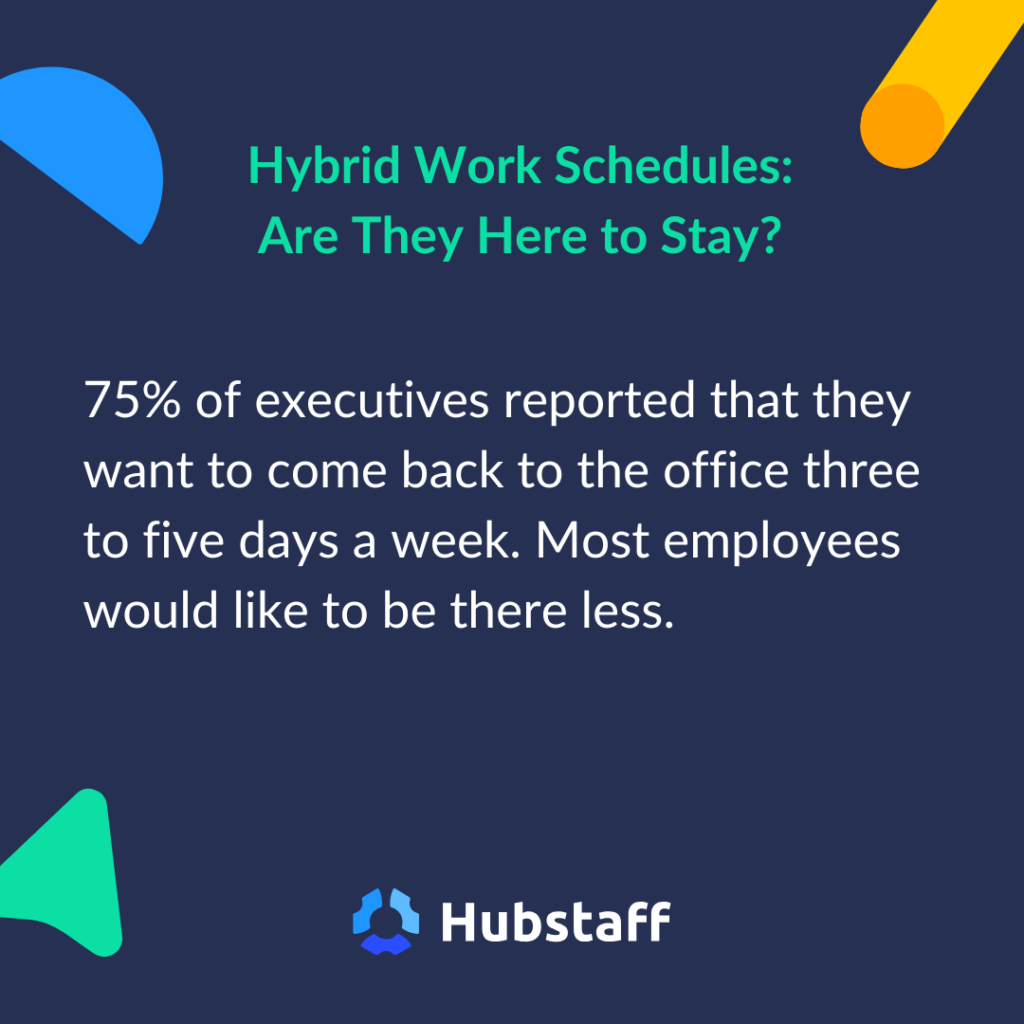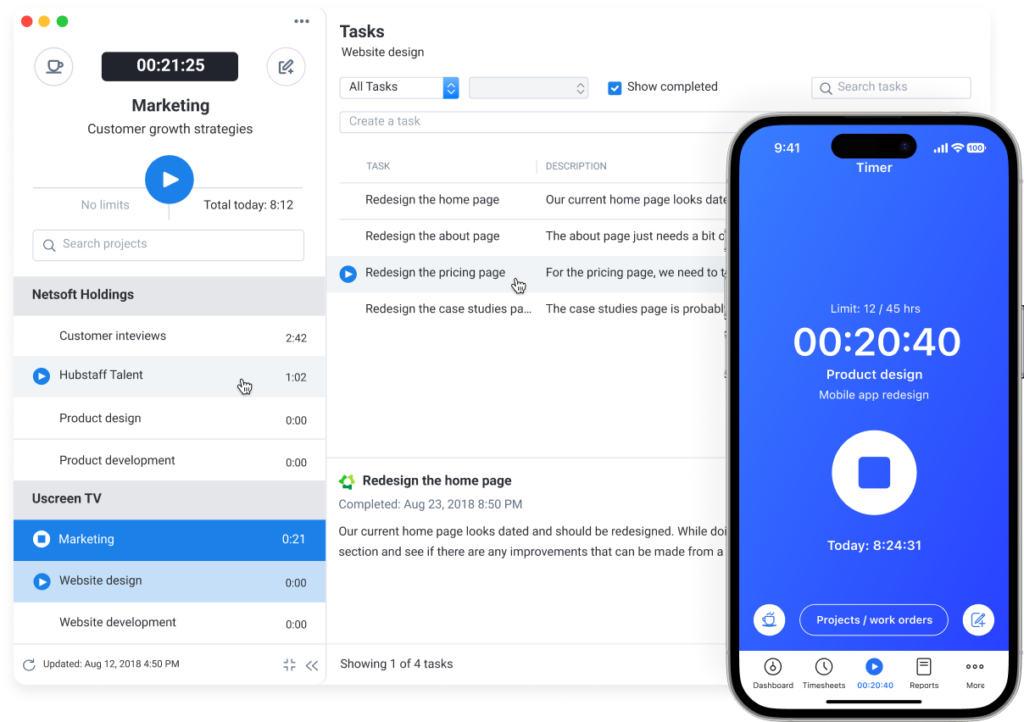As the name suggests, hybrid remote work combines traditional in-office work and more progressive remote work models. Many organizations have embraced this model to offer employees more flexibility while maintaining the stability and camaraderie often associated with in-office work.
Generally, people working for these companies may choose to work remotely, at a physical office, or find the right balance between the two options. They have a certain level of autonomy to work wherever they want as long as they keep up with deliverables, set guidelines, and other job-related responsibilities associated with in-office work.

In this post, we’ll explore the basics of the hybrid remote work model and how managers can structure hybrid work for their teams. We’ll also share a few noteworthy tips that may facilitate and simplify the transition to hybrid work.
So, without further ado, let’s get started.
Boost your team’s efficiency with Hubstaff's productivity tools
What is hybrid remote work?
Hybrid remote work is the sweet spot between fully remote or in-office work. It usually involves breaking up each week with a mix of in-office and remote work days.
It gets tricky because while you’ll still need to maintain an office space, you might not use it daily (or at least not with every employee in attendance). This may seem counterintuitive, but you can lean on co-working spaces to reap the benefits of hybrid working, making everything worthwhile.
The model enables you to cater to the diverse preferences of the workforce by creating an ideal hybrid work environment for everyone. Whether your workforce encompasses Generation Z, working mothers, or people with disabilities, hybrid work provides the most important component of your business (people) the flexibility they need.
Furthermore, employee engagement is significantly higher in companies that embrace hybrid remote working or go fully remote compared to those that prefer operations at a physical office.

The hybrid model serves as a fitting option for companies that can’t (or don’t want to) go fully remote. Different factors may come into play here, like the tasks that demand the workforce’s presence at a co-working space or the leader’s preference.
Plus, going fully remote is not as easy as it sounds and presents its share of challenges. So, implementing the hybrid work models may be a wise strategy at the start — even if your ultimate goal is a fully remote business.
Advantages of hybrid remote work
- Increased profits. Flexible work policies boost productivity and revenue growth. According to a Scoop report, companies with these policies outperform their non-hybrid counterparts in revenue growth.
- Cost savings. Hybrid work saves companies up to $11,000 per employee annually when they work from home 2 to 3 days a week (Global Workplace Analytics). Employees also save on commuting and other related expenses.
- Higher employee retention. Employees with flexible schedules are 33% less likely to leave their jobs and report greater satisfaction (Bureau of Labor Statistics). Additionally, 63% of job seekers prioritize work-life balance — another area where hybrid work thrives.
- Environmental benefits. Hybrid employees working from home 2 to 4 days weekly reduce their carbon footprint by up to 29% (National Academy of Sciences).
- Promotes inclusivity. Hybrid models accommodate diverse work styles and needs to enhance diversity, equity, and inclusion (DEI) efforts while driving better performance (McKinsey & Company).
Disadvantages of hybrid remote work
Like with anything, hybrid work doesn’t come without its fair share of disadvantages. Here are a few of the most notable downsides to remote work:
- Communication challenges. Digital communication tools can lead to misunderstandings, reduced team cohesion, and a lack of spontaneous interaction. Scheduling regular 1:1s with your team helps manage expectations and provide the support your team needs, while guides on asynchronous communication can improve workflows.
- Strain on work-life balance. Without clear boundaries, employees may face longer hours and burnout. To alleviate this, discuss engagement and stress in 1:1 meetings and use tools like Officevibe for anonymous feedback.
- Impact on company culture. Remote work can strain team dynamics and reduce a sense of belonging. Hosting activities like virtual retreats, in-person meetups, or creating casual Slack channels (e.g., #hobbies or #pubtrivia) can help maintain a strong culture.
Hybrid remote work models
The hybrid remote work model encompasses four core classifications that companies can consider. Each model has its own advantages and disadvantages, making them all viable choices for different use cases.
1. Office-first hybrid work model
A company implementing an office-first hybrid work model expects its employees to be on-site most of the time and allows them to work remotely for a few days each pay period.
This model is popular with companies that perceive in-person collaboration at a physical location as fruitful for the business and expect to drive better results from it. These businesses don’t mind occasional remote activity but prefer employees be on site the vast majority of the time.
The advantages of implementing the office-first hybrid work model include:
- Better collaboration among different departments
- Improved teamwork
- Effective communication
- More networking opportunities
- Improved work culture
The model also encompasses the following disadvantages:
- Low flexibility
- Worse work-life balance
- High commuting costs
- Increased workplace expenses
- Increased potential for time off requests
Example schedule of an office-first hybrid model
In an office-first hybrid setup, employees must work on-site most of the week, with limited remote flexibility.
Here’s what a weekly office-first hybrid schedule might look like:
- Monday to Thursday: In-office work for team meetings, collaboration, and focused work at a physical desk.
- Friday: Remote workday to complete individual tasks, catch up on emails, or tackle deep-focus projects without office distractions.
Often, hybrid work means two or three days of either remote or office work. It’s common to see office-first hybrid schedules with only one remote working day.
This setup may also come in different, more flexible forms, like four to five remote days per month that may be used at each employee’s discretion.

2. Flexible hybrid work model
This hybrid work schedule model offers more flexibility to employees than the office-first hybrid work model. Employees can design their hybrid schedules and choose the days they’ll work remotely.
According to this model, if employees think working remotely can help them better focus on a particular project or task and achieve optimal results, they can choose to do so.
The advantages of implementing this model include:
- Easy recruitment
- High employee satisfaction
- High employee engagement
- High employee retention
- Reduced commuting costs
The disadvantages of implementing the model are:
- Underutilization of equipment and office space
- Less direct team communication
- More effort in building team chemistry and camaraderie
- Greater emphasis on building trust due to more discretion
Example schedule of a flexible hybrid model
In a flexible hybrid model, employees can choose which days they work remotely or on-site. This gives them more freedom to fit personal needs and job requirements into their schedules.
- Monday: Remote workday to catch up on tasks that have carried over from the previous week or run personal errands.
- Tuesday: In-office work for team meetings and collaboration.
- Wednesday: Remote workday for deep-focus projects or tasks requiring minimal interruptions.
- Thursday: In-office work to align with team priorities, participate in in-person strategic discussions, and maintain camaraderie with happy hours and other after-work events.
- Friday: Remote or in-office, depending on personal preference or project needs.
Some flexible hybrid setups allow employees to log two to three in-office days per week or set a minimum monthly requirement for on-site work.
This model is ideal for those seeking work-life balance while staying closely engaged in team efforts. It’s also great for companies on a budget looking for recruiting perks to offset reduced salaries.
3. Fixed hybrid work model
This model requires companies to specify the days their respective teams will work remotely or on-site. For example, an employer can allow a team to operate remotely only on Thursday and Friday. For the rest of the days, they should be active on-site.
Here are a few of the advantages of implementing this model:
- Hassle-free management for team leaders
- Improved coordination
- Better performance tracking
- Minimal shift scheduling conflicts
The disadvantages of implementing the model worth mentioning are:
- Minimal flexibility
- Decreased employee satisfaction
- Poor focus at work
Example schedule of a fixed hybrid model
In a fixed hybrid model, employees work remotely and on-site on designated days, creating a consistent and predictable routine.
Here’s an example of a weekly schedule:
- Monday: Remote workday for focused planning and catching up on tasks from the previous week.
- Tuesday to Thursday: In-office work for team meetings, collaboration, and hands-on projects.
- Friday: Remote workday to ease into the weekend with light, individual tasks. This setup lets employees reflect on the week’s accomplishments and prepare for Monday feeling refreshed.
This structure gives employees an extended stay at home while maintaining in-office collaboration during the core middle of the week.
4. Remote-first hybrid work model
The companies implementing this model are reminiscent of those that are fully remote. The only difference is that the employees occasionally commute to a physical location for certain tasks or team-building activities.
These activities might include:
- Collaborative tasks
- Training sessions
- Internal meetings
- Physical project deliverables
Some companies following this model may not even have a permanent office space and choose to rent one as needed.
Companies can use communication technologies, contact center software, or time tracking tools for project managers to further enhance team collaboration and productivity.
The key benefits encompassing this model include:
- Enhanced employee productivity
- Increased employee satisfaction
- Higher flexibility
- Reduced costs
- Easy recruitment
- Improved retention
The disadvantages of implementing the model include:
- Lack of interaction among employees
- Less team bonding
- Hybrid remote team members working in silos
- High overhead costs for limited office use
- Lack of in-office experience
Example schedule of a remote-first hybrid work model
In a remote-first hybrid model, most work happens remotely, with occasional in-office days for specific needs.
- Monday to Thursday: Fully remote work to focus on tasks, projects, and virtual collaboration.
- Friday: Optional in-office day for team bonding, project kickoffs, or meetings requiring physical presence.
Due to the flexible nature of remote work, there are endless ways to structure this type of schedule.
- Five minimum in-office days required per month: Employees can schedule these flexibly based on project needs or personal preferences.
- Quarterly in-person meetings: Teams gather on-site every three months for strategy sessions or large-scale planning.
- Team-specific schedules: Different departments set office visit requirements based on roles and collaboration needs.
- On-demand office use: Employees can work on-site whenever needed but aren’t required to follow a fixed in-office schedule.
- Client-related office visits: Employees come on-site for critical client meetings, such as onboarding a new client or conducting key presentations.
Tips for implementing a hybrid remote work model
Choosing the right hybrid work model for you and implementing it may not be as easy as it sounds. The following are a few recommendations that may help you successfully implement the model of your choice and ensure optimal results from it:
1. Choose a fitting model
It goes without saying that the first step to implementing a hybrid work model in a workplace is selecting the one that best fits your requirements.
We’ve provided four classifications of the hybrid work model. To identify the one best suited for you, it’s important to know what you want to achieve from the transition to drive optimal results.
Once you know what you want, reach out to your employees and hear their preferences. The goal here is to find the right balance between what you desire and what your workforce prefers. Inability to compromise can negatively impact retention.
2. Set clear expectations
No matter which hybrid work model you choose, you should always set clear expectations and goals. This means you should have clear job descriptions and effectively communicate what you expect from your remote employees regarding their performance.
You’ll need to develop the core metrics you plan to use to assess performance. This will enable you to uncover the insights that help grow your business.

3. Create transparent workflows
You need to create transparent workflows to ensure the effective implementation of the hybrid work model. This means documenting processes, roles, and responsibilities before the transition commences to minimize any confusion across the workforce. This also minimizes the transition process’s impact on overall productivity and ensures that you don’t lose ground on your deliverables when making these changes.
4. Ensure coordination
Effective coordination is the key to ensuring success regardless of which hybrid work model you choose. For this, you should consider scheduling team-wide and interdepartmental meetings. There are a variety of meeting formats that you can explore, like:
- 1:1s
- Daily Stand-ups
- Weekly performance update meetings
- Brainstorming sessions
- Monthly town hall meetings

This allows you to consistently track team performance, get acquainted with their concerns, and guide them along the way.
5. Be flexible with remote workers
While the hybrid work model is different from traditional ways of working, it helps you improve employee retention and enables you to widen the talent pool to hire the best personnel available in your respective industry.
If you’re still skeptical about hybrid work, the office-first model is still more flexible than a fully in-office approach. It still offers employees a certain level of freedom while allowing managers to get acclimated to managing remote work.
6. Ensure effective communication among hybrid and remote workers
Ensuring effective communication can be tricky when you choose to transition into a hybrid workspace. Your teams won’t always be available under one roof. For that reason, it can be difficult to ensure that everyone is on the same page.
To overcome this challenge, start by maintaining a centralized database or portal where you keep all necessary documents and ensure each of your teams has access to this hub of information. Tools like Notion, Evernote, and Google Drive are helpful here.
Furthermore, you should have a standardized channel for communication. This will help your teams communicate effectively in real time, join video conferencing when needed and collaborate on different tasks without being physically present at the same location. Tools like Slack and Microsoft Teams tend to top the list here. Additionally, if your team needs to record presentations or training sessions for remote members, using an online screen recorder can be a practical solution for sharing high-quality video content effortlessly.
7. Be patient
Do not expect the operations to be in full throttle during the transition to a hybrid remote work schedule — or even immediately after. It’s a no-brainer that your teams will take some time to get used to the new ways of working. So, a few missed deadlines or minor productivity fluctuations should not raise the alarms for you.
Be patient with your team and give them time to get their flow back. They may end up being more productive working from home than they are in the office.
8. Keep tracking
Keep an eye on the key metrics once you have successfully implemented your model of choice. You already have set expectations for the transition. So, just keep tracking things to ensure that you’re moving in the right direction. Time and productivity tracking tools like Hubstaff can help here.

9. Create a discrimination-free hybrid work environment
Don’t discriminate against employees based on their preferences. Those who choose to work remotely and those who prefer to work on-site should get to enjoy the same access to perks and benefits.
Discriminating against teams that choose to stay active remotely will be counterintuitive and may lead to conflicts down the road. In fact, research shows that remote workers are more productive.
Frequently asked questions
What is the difference between hybrid, on-site, and remote work?
Hybrid work blends time between the office and remote locations, combining flexibility with in-person collaboration. On-site work requires employees to be present at a physical office full-time, with no remote option. Remote work happens entirely outside a traditional office, offering complete location — and, in some cases, schedule — independence.
How many days are spent in the office in hybrid remote work?
The number of days an employee works in the office in a hybrid remote model varies by organization. Common setups include 2 to 3 days of in-office work per week. Some models, like fixed hybrid schedules, have predetermined remote days, while flexible hybrid arrangements let employees choose their remote and in-office days.
Can hybrid work be fully remote?
While hybrid models may lean heavily toward remote work, they aren’t typically “fully remote” because they involve at least occasional office days. In contrast, a fully remote setup not only removes location constraints but often comes with tools and policies that support asynchronous communication and total flexibility. Hybrid work, by definition, bridges both worlds, so a “fully remote hybrid” model is a semantic contradiction.
Final words
Hybrid remote teams with a successful transition get to enjoy a variety of benefits. You’ll likely see a boost in employee satisfaction that can have a positive impact on retention (which then leads to better cost savings). By offering your company a better work-life balance, you’ll also have access to a larger talent pool in your respective industry.
Have any of your own remote and hybrid work success stories? Any ways to bridge the gap and maintain the culture of an in-office environment using hybrid work schedules? We’d love to hear from you.
Most popular
The Critical Role of Employee Monitoring and Workplace Security
Why do we need employee monitoring and workplace security? Companies had to adapt fast when the world shifted to remote work...
15 Ways to Use AI in the Workforce
Whether through AI-powered project management, strategic planning, or simply automating simple admin work, we’ve seen a dramatic...
The AI Productivity Panel: Lessons From Leaders on What’s Working (and What’s Not)
When I moderated this AI productivity panel, I expected a solid conversation. What I didn’t expect was the flood of real-world i...
Employee Performance Dashboards: Templates, Tools, and Best Practices
Keeping track of how your team’s really doing can be tricky. Spreadsheets pile up, one-on-ones only tell part of the story, and...





